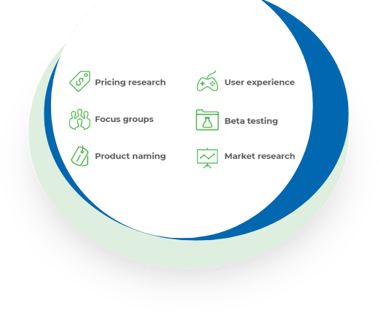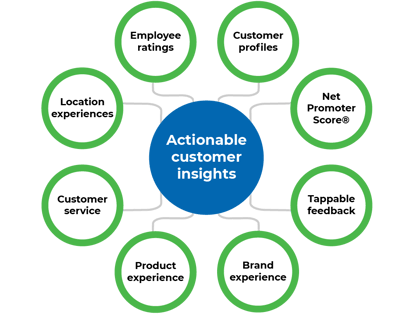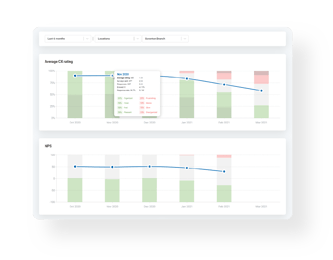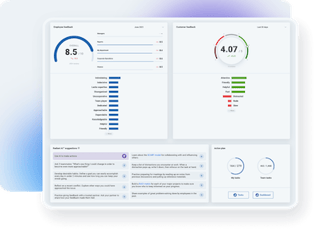
The Importance of Customer Feedback in the Digital Era
In today's digital landscape, customer feedback has emerged as a critical component of business success. As businesses continue to adapt to the digital era and embrace digital transformation, the role of customer feedback has evolved significantly. With the widespread adoption of new digital technologies, customers have come to expect more from businesses than ever before. They demand personalized experiences, seamless interactions, and solutions that cater to their unique needs. In this digital age, businesses that actively seek, listen to, and act upon customer feedback are gaining a competitive advantage and achieving greater success.
The digital era has brought about a fundamental shift in the way businesses approach customer feedback. In the past, customer feedback was often collected through traditional means such as surveys, focus groups, and in-person interactions. However, with the advent of digital technologies, the landscape of customer feedback has changed dramatically. Today, businesses have access to a plethora of digital channels and tools that enable them to capture, measure, and analyze customer feedback in real-time. Online surveys, social media listening, customer reviews, and sentiment analysis are just a few examples of the digital feedback channels that businesses can leverage to gain insights into customer preferences, behaviors, and pain points.
Feedback-driven product development
 One of the key ways in which customer feedback is shaping the customer experience in the digital era is through feedback-driven product development. Businesses are increasingly using customer feedback as a valuable source of insights for product development. By actively listening to customer feedback, businesses can identify gaps in their products or services, uncover opportunities for improvement, and develop offerings that are better aligned with customer needs and expectations. In the digital era, businesses can collect feedback from various touchpoints throughout the customer journey, such as online surveys, product reviews, and social media comments. This feedback is then analyzed and used to inform product development decisions, resulting in products that are more customer-centric and better meet their evolving demands.
One of the key ways in which customer feedback is shaping the customer experience in the digital era is through feedback-driven product development. Businesses are increasingly using customer feedback as a valuable source of insights for product development. By actively listening to customer feedback, businesses can identify gaps in their products or services, uncover opportunities for improvement, and develop offerings that are better aligned with customer needs and expectations. In the digital era, businesses can collect feedback from various touchpoints throughout the customer journey, such as online surveys, product reviews, and social media comments. This feedback is then analyzed and used to inform product development decisions, resulting in products that are more customer-centric and better meet their evolving demands.
Personalized experiences based on feedback
Moreover, customer feedback is also driving the trend of personalized experiences in the digital era. Today's customers expect businesses to understand their preferences, behaviors, and needs, and deliver personalized experiences across various touchpoints. Customer feedback plays a crucial role in enabling businesses to create personalized offerings. By analyzing feedback data, businesses can gain insights into individual customer preferences, purchase history, and pain points. This information can then be used to tailor marketing messages, offers, and recommendations, making the customer experience more relevant and engaging. Personalization not only enhances the overall customer experience but also strengthens customer loyalty and retention, as customers are more likely to remain loyal to brands that understand and cater to their unique needs.
Real-time issue resolution
Real-time issue resolution is another critical aspect of customer feedback in the digital era. With the proliferation of social media and online review sites, customers have become more vocal about their experiences with businesses, both positive and negative. This has made it imperative for businesses to actively monitor and respond to customer feedback in real-time. Promptly addressing customer issues and concerns is crucial to demonstrate a commitment to customer satisfaction and build trust. Businesses that proactively address negative feedback and provide timely solutions can turn a negative experience into a positive one, thus retaining customers who might otherwise have switched to a competitor. Real-time issue resolution also helps businesses identify recurring problems or pain points and take corrective actions promptly, thereby improving their overall customer experience and reputation.
Continuous improvement using feedback loops
 In the digital era, customer feedback is no longer a one-time activity but a continuous process of gathering, analyzing, and acting upon feedback. Businesses are leveraging technology to automate feedback collection, analysis, and reporting, enabling them to gather feedback in real-time and make data-driven decisions. This feedback loop allows businesses to continuously improve their products, services, and processes based on customer insights. By staying agile and responsive to changing customer expectations and market dynamics, businesses can maintain a competitive edge in the digital landscape. Additionally, a robust feedback loop can also foster a culture of customer-centricity within the organization, where everyone from frontline employees to top executives is empowered to gather and act upon customer feedback.
In the digital era, customer feedback is no longer a one-time activity but a continuous process of gathering, analyzing, and acting upon feedback. Businesses are leveraging technology to automate feedback collection, analysis, and reporting, enabling them to gather feedback in real-time and make data-driven decisions. This feedback loop allows businesses to continuously improve their products, services, and processes based on customer insights. By staying agile and responsive to changing customer expectations and market dynamics, businesses can maintain a competitive edge in the digital landscape. Additionally, a robust feedback loop can also foster a culture of customer-centricity within the organization, where everyone from frontline employees to top executives is empowered to gather and act upon customer feedback.
Brand reputation, trust, and customer loyalty
Another critical aspect of customer feedback in the digital era is the impact it has on brand reputation and customer trust. In today's digital world, where information travels fast and is easily accessible to a wide audience, a single negative review or social media comment can quickly tarnish a brand's reputation. On the other hand, positive customer feedback can boost a brand's image and attract new customers. Therefore, businesses need to actively manage their online reputation by monitoring and responding to customer feedback across various online channels. By acknowledging and addressing customer feedback, businesses can demonstrate their commitment to customer satisfaction and build trust among their customer base. This, in turn, can lead to increased customer loyalty, positive word-of-mouth, and ultimately, business growth.
Long-term strategic planning
In addition to the immediate benefits, customer feedback also provides businesses with valuable insights for long-term strategic planning. By analyzing customer feedback data, businesses can gain a deeper understanding of customer preferences, expectations, and trends. This information can inform strategic decisions such as new product development, market expansion, and customer segmentation. For instance, if a business consistently receives feedback from customers about a particular feature missing in their product, they can consider incorporating it in their next product update or release. By aligning their strategies with customer feedback, businesses can ensure that their offerings remain relevant and competitive in the ever-changing digital landscape.
Competitive intelligence
Furthermore, customer feedback serves as a valuable source of competitive intelligence. In the digital era, businesses face intense competition, and staying ahead requires a deep understanding of customer needs and expectations. By analyzing customer feedback, businesses can gain insights into how they compare to their competitors in terms of product quality, customer service, pricing, and overall customer experience. This information can help businesses identify their strengths and weaknesses relative to their competitors and make informed decisions to stay ahead in the market. For example, if a business consistently receives feedback about their competitors offering better pricing, they can adjust their pricing strategy to remain competitive.
Resource planning and workforce optimization
Incorporating customer feedback into the decision-making process also helps businesses prioritize their efforts and resources. In today's fast-paced digital environment, businesses have limited resources and need to make strategic choices about where to invest their time, money, and efforts. Customer feedback can provide valuable guidance on where businesses should focus their attention. By identifying the most pressing customer pain points or areas of improvement through feedback analysis, businesses can prioritize their efforts and allocate resources accordingly. This ensures that businesses are addressing the most critical customer needs, which can lead to higher customer satisfaction, loyalty, and ultimately, business success.
Social media listening
In the digital era, social media has emerged as a powerful platform for customer feedback. Customers now use social media channels to express their opinions, share their experiences, and seek support from businesses. Social media listening, which involves monitoring and analyzing social media conversations about a brand or product, has become a critical component of customer feedback management in the digital era. By actively listening to social media conversations, businesses can capture real-time feedback, identify emerging trends or issues, and respond promptly to customer inquiries or complaints. Social media listening also provides businesses with an opportunity to engage with customers, build relationships, and showcase their commitment to customer satisfaction. Additionally, social media platforms offer businesses valuable data and insights about customer sentiment, preferences, and behaviors, which can be used to inform product development, marketing strategies, and customer service initiatives.
However, managing customer feedback on social media can also present challenges for businesses. The sheer volume of feedback, the speed at which it is generated, and the potential for negative comments to go viral can overwhelm businesses and damage their reputation if not handled properly. Therefore, it is crucial for businesses to have a well-defined strategy and process in place for managing customer feedback on social media effectively. This may involve setting up dedicated social media listening tools or teams, establishing guidelines for responding to customer feedback, and training employees on how to handle customer inquiries or complaints on social media in a timely and professional manner.
Automation and data analytics
 Another important aspect of managing customer feedback in the digital era is the use of technology and automation. With the advent of advanced analytics, machine learning, and artificial intelligence, businesses can leverage technology to collect, analyze, and respond to customer feedback more efficiently and effectively. For example, businesses can use sentiment analysis tools to automatically categorize customer feedback as positive, negative, or neutral based on the tone of the feedback. This can help businesses identify patterns and trends in customer feedback, prioritize issues that need immediate attention, and track changes in customer sentiment over time.
Another important aspect of managing customer feedback in the digital era is the use of technology and automation. With the advent of advanced analytics, machine learning, and artificial intelligence, businesses can leverage technology to collect, analyze, and respond to customer feedback more efficiently and effectively. For example, businesses can use sentiment analysis tools to automatically categorize customer feedback as positive, negative, or neutral based on the tone of the feedback. This can help businesses identify patterns and trends in customer feedback, prioritize issues that need immediate attention, and track changes in customer sentiment over time.
Natural language processing
Furthermore, businesses can use natural language processing (NLP) algorithms to automatically extract insights from customer feedback data, such as identifying recurring keywords, themes, or topics. This can provide businesses with valuable information about the specific pain points, preferences, or expectations of their customers. For instance, if a business receives multiple feedback comments related to a particular product feature, they can use NLP algorithms to extract and analyze the keywords associated with that feature, and use the insights to make data-driven decisions on how to improve the product.
Closed loop follow-up
Automation can also be used to streamline the process of collecting and responding to customer feedback. For instance, businesses can use automated feedback collection tools, such as online surveys or feedback forms, to collect feedback from customers in a systematic and scalable manner. These tools can be integrated with customer relationship management (CRM) systems or other business applications to automatically capture and analyze feedback data, and trigger alerts or notifications to relevant stakeholders when certain feedback thresholds are met. This can help businesses proactively identify and address customer issues, and ensure that feedback is acted upon in a timely manner.
Centralized customer feedback platforms
In addition to technology-driven automation, businesses can also leverage customer feedback through customer feedback management platforms. These platforms provide businesses with a centralized system to collect, analyze, and act upon customer feedback from various sources, such as surveys, reviews, social media, and customer support interactions. Customer feedback management platforms typically offer features such as sentiment analysis, data visualization, feedback tracking, and reporting, which can help businesses gain actionable insights from customer feedback data. These platforms can also facilitate collaboration among different teams within the organization, such as marketing, product development, and customer service, to ensure that customer feedback is shared and acted upon across the organization.
It's important to note that while technology and automation can significantly enhance the process of managing customer feedback, human involvement and judgment are still critical. Technology should be seen as an enabler, not a replacement, for human interactions and decision-making. Human empathy, intuition, and judgment are invaluable in interpreting the nuances of customer feedback, understanding the underlying emotions, and tailoring appropriate responses. Therefore, businesses should strike a balance between leveraging technology for efficiency and accuracy and maintaining a human touch in their customer feedback management process.
In conclusion, customer feedback is more important than ever in the digital era. It serves as a valuable source of insights for businesses to understand and meet customer needs, enhance customer satisfaction, and drive business success. By actively collecting, analyzing, and acting upon customer feedback, businesses can improve their products, services, and customer experiences, build customer trust and loyalty, and gain a competitive advantage. Technology and automation can significantly enhance the process of managing customer feedback, but human involvement and judgment are still crucial in interpreting the nuances of customer feedback and tailoring appropriate responses. Therefore, businesses should prioritize customer feedback as a strategic priority and integrate it into their decision-making process at all levels of the organization to thrive in the digital age.
To learn more about the Macorva Customer Experience platform, watch this 3 minute demo.






